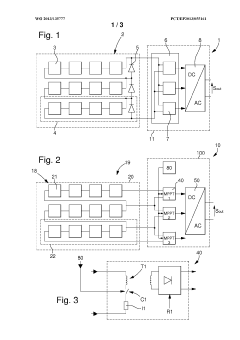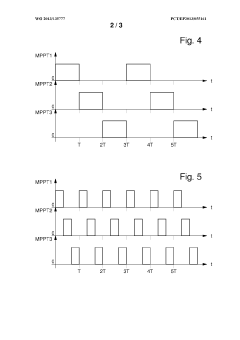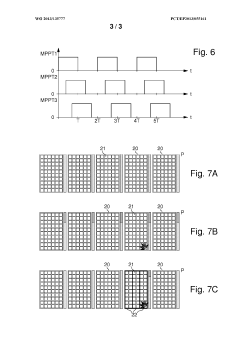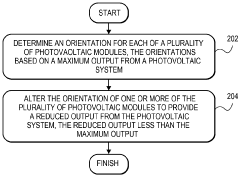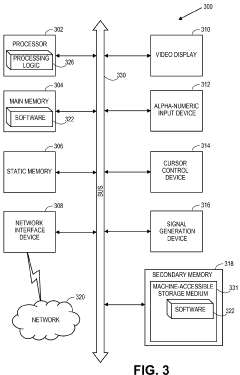How to Address Regulatory Challenges in Solar Inverter Deployment?
JUL 17, 20259 MIN READ
Generate Your Research Report Instantly with AI Agent
Patsnap Eureka helps you evaluate technical feasibility & market potential.
Regulatory Landscape
The regulatory landscape for solar inverter deployment is complex and dynamic, with varying requirements across different regions and jurisdictions. At the global level, organizations such as the International Electrotechnical Commission (IEC) set standards for solar inverters, focusing on safety, performance, and grid compatibility. These standards serve as a foundation for many national and regional regulations.
In the United States, the regulatory framework is multi-layered, involving federal, state, and local authorities. The Federal Energy Regulatory Commission (FERC) oversees grid interconnection standards, while individual states may have additional requirements. For instance, California's Rule 21 sets stringent standards for smart inverters, mandating advanced grid support functions.
The European Union has established a comprehensive regulatory framework through the Renewable Energy Directive and grid codes. These regulations emphasize grid stability, power quality, and the integration of renewable energy sources. Countries like Germany, with its high solar penetration, have implemented specific technical guidelines such as VDE-AR-N 4105 for low-voltage grid connection.
In emerging markets, regulatory frameworks are often in flux as governments seek to balance rapid solar adoption with grid stability concerns. Countries like India and China are developing new standards and regulations to address the unique challenges posed by their rapidly expanding solar sectors.
A key regulatory trend is the shift towards smart inverters capable of providing grid support functions. This includes requirements for voltage and frequency ride-through, reactive power control, and communication capabilities. These advanced features are becoming mandatory in many jurisdictions to enhance grid resilience and accommodate higher levels of distributed energy resources.
Cybersecurity is an emerging regulatory concern, with increasing focus on protecting solar inverters and associated control systems from potential cyber threats. Regulators are beginning to incorporate cybersecurity standards into their requirements, recognizing the critical role of inverters in grid stability and security.
Compliance with electromagnetic compatibility (EMC) standards is another crucial aspect of the regulatory landscape. These standards ensure that solar inverters do not interfere with other electronic devices and can operate reliably in various electromagnetic environments.
As the solar industry continues to evolve, regulators face the challenge of keeping pace with technological advancements. This has led to a trend towards more flexible, performance-based standards rather than prescriptive requirements. Such an approach allows for innovation while maintaining necessary safeguards for grid stability and safety.
In the United States, the regulatory framework is multi-layered, involving federal, state, and local authorities. The Federal Energy Regulatory Commission (FERC) oversees grid interconnection standards, while individual states may have additional requirements. For instance, California's Rule 21 sets stringent standards for smart inverters, mandating advanced grid support functions.
The European Union has established a comprehensive regulatory framework through the Renewable Energy Directive and grid codes. These regulations emphasize grid stability, power quality, and the integration of renewable energy sources. Countries like Germany, with its high solar penetration, have implemented specific technical guidelines such as VDE-AR-N 4105 for low-voltage grid connection.
In emerging markets, regulatory frameworks are often in flux as governments seek to balance rapid solar adoption with grid stability concerns. Countries like India and China are developing new standards and regulations to address the unique challenges posed by their rapidly expanding solar sectors.
A key regulatory trend is the shift towards smart inverters capable of providing grid support functions. This includes requirements for voltage and frequency ride-through, reactive power control, and communication capabilities. These advanced features are becoming mandatory in many jurisdictions to enhance grid resilience and accommodate higher levels of distributed energy resources.
Cybersecurity is an emerging regulatory concern, with increasing focus on protecting solar inverters and associated control systems from potential cyber threats. Regulators are beginning to incorporate cybersecurity standards into their requirements, recognizing the critical role of inverters in grid stability and security.
Compliance with electromagnetic compatibility (EMC) standards is another crucial aspect of the regulatory landscape. These standards ensure that solar inverters do not interfere with other electronic devices and can operate reliably in various electromagnetic environments.
As the solar industry continues to evolve, regulators face the challenge of keeping pace with technological advancements. This has led to a trend towards more flexible, performance-based standards rather than prescriptive requirements. Such an approach allows for innovation while maintaining necessary safeguards for grid stability and safety.
Market Demand Analysis
The global solar inverter market is experiencing significant growth, driven by the increasing adoption of solar energy systems worldwide. As countries strive to meet their renewable energy targets and reduce carbon emissions, the demand for solar inverters continues to rise. The market is expected to expand at a compound annual growth rate (CAGR) of over 8% from 2021 to 2026, with the residential and commercial sectors showing particularly strong growth potential.
The regulatory landscape plays a crucial role in shaping market demand for solar inverters. Governments worldwide are implementing policies and incentives to promote solar energy adoption, which directly impacts the demand for inverters. For instance, feed-in tariffs, net metering policies, and tax incentives have been instrumental in driving solar installations in many countries. However, regulatory challenges, such as stringent grid connection requirements and varying standards across different regions, can also create barriers to market growth.
In the residential sector, the increasing awareness of energy independence and the desire to reduce electricity bills are driving the demand for solar inverters. Homeowners are increasingly interested in smart home energy management systems, which integrate solar inverters with battery storage and home automation technologies. This trend is creating new opportunities for inverter manufacturers to develop advanced, grid-interactive products that can optimize energy consumption and provide grid support services.
The commercial and industrial sectors are also showing strong demand for solar inverters, particularly in regions with high electricity costs or unreliable grid infrastructure. Large-scale solar projects for businesses and industries require high-capacity inverters that can handle complex power management tasks and comply with grid codes. The growing emphasis on corporate sustainability goals is further fueling the adoption of solar energy systems in these sectors.
Utility-scale solar projects represent another significant market segment for inverters. As the cost of solar energy continues to decline, many countries are investing in large-scale solar farms to meet their renewable energy targets. This trend is driving demand for central inverters and string inverters optimized for utility-scale applications, with features such as advanced grid support capabilities and remote monitoring systems.
The market demand for solar inverters is also influenced by technological advancements. Innovations such as module-level power electronics (MLPE), hybrid inverters that can integrate with battery storage systems, and AI-powered smart inverters are gaining traction. These technologies offer improved efficiency, enhanced monitoring capabilities, and greater flexibility in system design, addressing some of the regulatory challenges associated with grid integration and power quality.
The regulatory landscape plays a crucial role in shaping market demand for solar inverters. Governments worldwide are implementing policies and incentives to promote solar energy adoption, which directly impacts the demand for inverters. For instance, feed-in tariffs, net metering policies, and tax incentives have been instrumental in driving solar installations in many countries. However, regulatory challenges, such as stringent grid connection requirements and varying standards across different regions, can also create barriers to market growth.
In the residential sector, the increasing awareness of energy independence and the desire to reduce electricity bills are driving the demand for solar inverters. Homeowners are increasingly interested in smart home energy management systems, which integrate solar inverters with battery storage and home automation technologies. This trend is creating new opportunities for inverter manufacturers to develop advanced, grid-interactive products that can optimize energy consumption and provide grid support services.
The commercial and industrial sectors are also showing strong demand for solar inverters, particularly in regions with high electricity costs or unreliable grid infrastructure. Large-scale solar projects for businesses and industries require high-capacity inverters that can handle complex power management tasks and comply with grid codes. The growing emphasis on corporate sustainability goals is further fueling the adoption of solar energy systems in these sectors.
Utility-scale solar projects represent another significant market segment for inverters. As the cost of solar energy continues to decline, many countries are investing in large-scale solar farms to meet their renewable energy targets. This trend is driving demand for central inverters and string inverters optimized for utility-scale applications, with features such as advanced grid support capabilities and remote monitoring systems.
The market demand for solar inverters is also influenced by technological advancements. Innovations such as module-level power electronics (MLPE), hybrid inverters that can integrate with battery storage systems, and AI-powered smart inverters are gaining traction. These technologies offer improved efficiency, enhanced monitoring capabilities, and greater flexibility in system design, addressing some of the regulatory challenges associated with grid integration and power quality.
Technical Challenges
The deployment of solar inverters faces several technical challenges that need to be addressed to ensure compliance with regulatory requirements. One of the primary issues is the variability of grid codes across different regions and countries. Solar inverter manufacturers must design their products to meet a wide range of specifications, which can vary significantly in terms of voltage and frequency ranges, power quality standards, and grid support functions.
Grid stability is another critical concern. As the penetration of solar energy increases, the impact on grid stability becomes more pronounced. Solar inverters must be capable of providing advanced grid support functions, such as reactive power control, voltage regulation, and frequency response. These features are essential for maintaining grid stability but can be complex to implement while ensuring compliance with diverse regulatory frameworks.
Electromagnetic compatibility (EMC) is a significant technical challenge in solar inverter deployment. Inverters must meet stringent EMC standards to prevent interference with other electronic devices and power systems. This requires careful design of power electronics, filtering systems, and shielding techniques. Achieving compliance with EMC regulations while maintaining high efficiency and low cost is a delicate balance that manufacturers must strike.
Cybersecurity has emerged as a crucial technical challenge in recent years. As solar inverters become more connected and integrated into smart grid systems, they become potential targets for cyber attacks. Implementing robust security measures that comply with evolving regulatory requirements while maintaining system performance and user accessibility is a complex task.
Thermal management is another technical hurdle in solar inverter design. Efficient heat dissipation is crucial for maintaining inverter performance and longevity, especially in harsh environmental conditions. Balancing thermal management with size, weight, and cost constraints while meeting regulatory standards for safety and reliability presents a significant engineering challenge.
The rapid evolution of energy storage technologies introduces additional complexities. Hybrid inverters that integrate battery storage must comply with both solar and energy storage regulations, which can differ significantly. Ensuring seamless operation and compliance across multiple regulatory domains adds another layer of technical complexity to inverter design and deployment.
Lastly, the increasing demand for remote monitoring and control capabilities in solar inverters presents challenges in data privacy and communication protocols. Manufacturers must implement secure, standardized communication interfaces that comply with data protection regulations while providing the necessary functionality for efficient system management and grid integration.
Grid stability is another critical concern. As the penetration of solar energy increases, the impact on grid stability becomes more pronounced. Solar inverters must be capable of providing advanced grid support functions, such as reactive power control, voltage regulation, and frequency response. These features are essential for maintaining grid stability but can be complex to implement while ensuring compliance with diverse regulatory frameworks.
Electromagnetic compatibility (EMC) is a significant technical challenge in solar inverter deployment. Inverters must meet stringent EMC standards to prevent interference with other electronic devices and power systems. This requires careful design of power electronics, filtering systems, and shielding techniques. Achieving compliance with EMC regulations while maintaining high efficiency and low cost is a delicate balance that manufacturers must strike.
Cybersecurity has emerged as a crucial technical challenge in recent years. As solar inverters become more connected and integrated into smart grid systems, they become potential targets for cyber attacks. Implementing robust security measures that comply with evolving regulatory requirements while maintaining system performance and user accessibility is a complex task.
Thermal management is another technical hurdle in solar inverter design. Efficient heat dissipation is crucial for maintaining inverter performance and longevity, especially in harsh environmental conditions. Balancing thermal management with size, weight, and cost constraints while meeting regulatory standards for safety and reliability presents a significant engineering challenge.
The rapid evolution of energy storage technologies introduces additional complexities. Hybrid inverters that integrate battery storage must comply with both solar and energy storage regulations, which can differ significantly. Ensuring seamless operation and compliance across multiple regulatory domains adds another layer of technical complexity to inverter design and deployment.
Lastly, the increasing demand for remote monitoring and control capabilities in solar inverters presents challenges in data privacy and communication protocols. Manufacturers must implement secure, standardized communication interfaces that comply with data protection regulations while providing the necessary functionality for efficient system management and grid integration.
Compliance Solutions
01 Grid-tied solar inverter systems
Grid-tied solar inverter systems are designed to connect photovoltaic arrays to the utility grid. These systems typically include features for maximum power point tracking, DC-to-AC conversion, and grid synchronization. They often incorporate safety mechanisms such as anti-islanding protection and may support bidirectional power flow for grid services.- Grid-tied solar inverter systems: Grid-tied solar inverter systems are designed to connect solar panels to the utility grid. These systems convert DC power from solar panels into AC power compatible with the grid, allowing for bidirectional power flow. They often include features like maximum power point tracking (MPPT) and anti-islanding protection for safety and efficiency.
- Microinverter technology: Microinverters are small inverters attached to individual solar panels or small groups of panels. They convert DC to AC at the panel level, offering advantages such as improved efficiency, easier system scalability, and better performance in partial shading conditions. Microinverters also provide panel-level monitoring and can enhance system reliability.
- Power optimization and management: Solar inverters incorporate various power optimization and management techniques to maximize energy yield and system efficiency. These may include advanced MPPT algorithms, reactive power control, and intelligent power management systems that adapt to changing environmental conditions and grid requirements.
- Safety and protection features: Solar inverters integrate multiple safety and protection features to ensure reliable operation and prevent damage to the system or grid. These may include ground fault detection, surge protection, over/under voltage protection, and thermal management systems. Advanced inverters also incorporate smart grid functionalities for grid support and stability.
- Energy storage integration: Modern solar inverters often include capabilities for integrating energy storage systems, such as batteries. These hybrid inverters can manage power flow between solar panels, batteries, and the grid, enabling features like self-consumption optimization, backup power during outages, and time-of-use energy management.
02 Microinverter technology
Microinverters are small inverters attached to individual solar panels or small groups of panels. They convert DC to AC at the panel level, offering advantages such as improved system efficiency, easier installation, and enhanced monitoring capabilities. Microinverters can also mitigate the effects of partial shading on overall system performance.Expand Specific Solutions03 Power optimization and management
Solar inverters incorporate various power optimization and management techniques to maximize energy yield and system efficiency. These may include advanced maximum power point tracking algorithms, reactive power control, and intelligent power management systems that can adapt to changing environmental conditions and grid requirements.Expand Specific Solutions04 Inverter safety and protection features
Modern solar inverters integrate multiple safety and protection features to ensure reliable operation and compliance with grid codes. These may include ground fault detection, arc fault protection, overvoltage and undervoltage protection, and thermal management systems. Advanced inverters also incorporate smart grid functionalities for grid support and stability.Expand Specific Solutions05 Multi-level and modular inverter designs
Multi-level and modular inverter designs are emerging trends in solar inverter technology. These architectures offer benefits such as improved efficiency, reduced harmonic distortion, and enhanced reliability through redundancy. Modular designs also allow for easier scalability and maintenance of large-scale solar installations.Expand Specific Solutions
Key Industry Players
The regulatory landscape for solar inverter deployment is evolving rapidly, reflecting the industry's growth and technological advancements. The market is in a mature growth phase, with global solar inverter market size expected to reach $27.3 billion by 2026. Technological maturity varies among key players, with companies like Enphase Energy, SolarEdge Technologies, and SMA Solar Technology leading in innovation. These firms are developing advanced inverter technologies to address regulatory challenges, such as grid integration, power quality, and safety standards. Emerging players like Ampt LLC and Nextracker LLC are also contributing to the competitive landscape by focusing on specialized solutions to meet evolving regulatory requirements.
Enphase Energy, Inc.
Technical Solution: Enphase Energy addresses regulatory challenges in solar inverter deployment through its innovative microinverter technology. The company's IQ8 microinverters are designed to comply with various international standards, including UL 1741 and IEEE 1547, ensuring grid stability and safety[1]. Enphase's Ensemble energy management technology enables grid-agnostic operation, allowing systems to function both on and off-grid, which helps navigate complex regulatory environments[2]. The company also implements advanced grid support functions, such as reactive power control and voltage ride-through capabilities, to meet evolving grid codes worldwide[3].
Strengths: Highly adaptable to different regulatory environments, scalable solution for various system sizes. Weaknesses: Higher initial cost compared to string inverters, may require specialized installation knowledge.
SolarEdge Technologies, Inc.
Technical Solution: SolarEdge tackles regulatory challenges with its HD-Wave inverter technology and power optimizers. The company's inverters feature advanced grid support functionalities, including low voltage ride-through (LVRT) and reactive power control, which comply with stringent grid codes globally[4]. SolarEdge's SafeDC™ technology addresses safety regulations by reducing DC voltage to touch-safe levels when the system is disconnected from the grid[5]. The company also offers country-specific inverter settings that can be easily configured to meet local regulatory requirements, streamlining the deployment process across different regions[6].
Strengths: Comprehensive compliance with global standards, enhanced safety features. Weaknesses: Reliance on proprietary power optimizer technology may limit flexibility in system design.
Innovative Approaches
Renewable energy unit having a simplified connector technology
PatentWO2013135777A2
Innovation
- An electronic device with an energy module connected to an inverter system where each group of renewable energy-producing means is controlled independently by regulator circuits, eliminating the need for integrated diodes by directly connecting each group to a regulator circuit, thereby preventing current flow between groups.
Photovoltaic system with managed output an method of managing variability of output from a photovoltaic system
PatentWO2011112350A2
Innovation
- Implementing a photovoltaic system with sensors and orientation systems that adjust the tilt of photovoltaic modules to reduce solar energy collection capability, combined with advanced tracker controllers and weather monitoring systems to predict and manage output variability, allowing for more precise control of electrical output.
Grid Integration
Grid integration is a critical aspect of addressing regulatory challenges in solar inverter deployment. As solar energy becomes increasingly prevalent in the power generation mix, the integration of solar inverters into existing grid infrastructure presents both opportunities and challenges.
One of the primary concerns in grid integration is maintaining grid stability and power quality. Solar inverters must comply with strict regulatory standards to ensure they do not introduce harmful harmonics or voltage fluctuations into the grid. Advanced inverter technologies, such as smart inverters, are being developed to address these issues by providing reactive power support and voltage regulation capabilities.
Interconnection requirements vary across different regions and utilities, creating a complex regulatory landscape for solar inverter manufacturers and installers. To streamline the integration process, many jurisdictions are adopting standardized interconnection procedures and technical requirements. These standards aim to simplify the approval process while ensuring the safety and reliability of the grid.
The increasing penetration of distributed solar generation has led to concerns about grid congestion and reverse power flow. To mitigate these issues, regulators are implementing new policies and technical solutions. For example, some regions are adopting advanced distribution management systems (ADMS) that can dynamically manage the flow of power from distributed resources, including solar inverters.
Energy storage integration is emerging as a key strategy to enhance the grid integration of solar inverters. By pairing solar systems with battery storage, the variability of solar generation can be smoothed out, providing more consistent power output and grid support services. Regulators are developing frameworks to incentivize the deployment of solar-plus-storage systems and to define their role in grid operations.
Cybersecurity is another critical aspect of grid integration for solar inverters. As these devices become more connected and intelligent, they also become potential targets for cyber attacks. Regulators are working to establish cybersecurity standards and protocols to protect the grid from vulnerabilities introduced by solar inverters and other distributed energy resources.
Looking ahead, the development of smart grids and the implementation of advanced communication protocols will play a crucial role in addressing grid integration challenges. Technologies such as blockchain and artificial intelligence are being explored to enhance the coordination and control of distributed solar resources, potentially revolutionizing the way solar inverters interact with the grid.
One of the primary concerns in grid integration is maintaining grid stability and power quality. Solar inverters must comply with strict regulatory standards to ensure they do not introduce harmful harmonics or voltage fluctuations into the grid. Advanced inverter technologies, such as smart inverters, are being developed to address these issues by providing reactive power support and voltage regulation capabilities.
Interconnection requirements vary across different regions and utilities, creating a complex regulatory landscape for solar inverter manufacturers and installers. To streamline the integration process, many jurisdictions are adopting standardized interconnection procedures and technical requirements. These standards aim to simplify the approval process while ensuring the safety and reliability of the grid.
The increasing penetration of distributed solar generation has led to concerns about grid congestion and reverse power flow. To mitigate these issues, regulators are implementing new policies and technical solutions. For example, some regions are adopting advanced distribution management systems (ADMS) that can dynamically manage the flow of power from distributed resources, including solar inverters.
Energy storage integration is emerging as a key strategy to enhance the grid integration of solar inverters. By pairing solar systems with battery storage, the variability of solar generation can be smoothed out, providing more consistent power output and grid support services. Regulators are developing frameworks to incentivize the deployment of solar-plus-storage systems and to define their role in grid operations.
Cybersecurity is another critical aspect of grid integration for solar inverters. As these devices become more connected and intelligent, they also become potential targets for cyber attacks. Regulators are working to establish cybersecurity standards and protocols to protect the grid from vulnerabilities introduced by solar inverters and other distributed energy resources.
Looking ahead, the development of smart grids and the implementation of advanced communication protocols will play a crucial role in addressing grid integration challenges. Technologies such as blockchain and artificial intelligence are being explored to enhance the coordination and control of distributed solar resources, potentially revolutionizing the way solar inverters interact with the grid.
Safety Standards
Safety standards play a crucial role in addressing regulatory challenges in solar inverter deployment. These standards ensure the safe and reliable operation of solar inverters, protecting both the electrical grid and end-users. The International Electrotechnical Commission (IEC) has developed several key standards that govern solar inverter safety, including IEC 62109-1 and IEC 62109-2.
IEC 62109-1 focuses on general safety requirements for power converters used in photovoltaic systems. It covers aspects such as electrical shock hazards, energy hazards, fire hazards, mechanical hazards, and environmental factors. This standard provides a comprehensive framework for manufacturers to design and test their inverters to ensure compliance with safety regulations.
IEC 62109-2 specifically addresses the particular safety requirements for grid-connected inverters. It builds upon the general requirements outlined in IEC 62109-1 and includes additional provisions for grid protection, islanding prevention, and power quality. These standards are essential for ensuring that solar inverters can safely interact with the electrical grid without causing disruptions or safety hazards.
In addition to IEC standards, many countries have their own national safety standards for solar inverters. For example, in the United States, UL 1741 is the primary safety standard for inverters, converters, and controllers used in standalone or grid-connected power systems. This standard is harmonized with IEEE 1547, which addresses the interconnection of distributed energy resources with electric power systems.
Compliance with these safety standards is typically verified through rigorous testing and certification processes. Third-party certification bodies, such as UL, TÜV, and DNV GL, conduct extensive tests to ensure that solar inverters meet the required safety standards before they can be deployed in the field.
As the solar energy industry continues to evolve, safety standards are regularly updated to address new technologies and emerging challenges. For instance, the increasing integration of energy storage systems with solar inverters has led to the development of new safety standards, such as UL 9540 for energy storage systems and equipment.
To address regulatory challenges effectively, solar inverter manufacturers must stay informed about the latest safety standards and regulatory requirements in their target markets. This often involves engaging with industry associations, participating in standards development processes, and maintaining open communication channels with regulatory bodies.
Furthermore, as smart grid technologies advance, safety standards are expanding to include cybersecurity requirements. This is crucial for protecting solar inverters and the broader power system from potential cyber threats. Standards such as IEC 62443 for industrial communication networks are becoming increasingly relevant for solar inverter manufacturers.
IEC 62109-1 focuses on general safety requirements for power converters used in photovoltaic systems. It covers aspects such as electrical shock hazards, energy hazards, fire hazards, mechanical hazards, and environmental factors. This standard provides a comprehensive framework for manufacturers to design and test their inverters to ensure compliance with safety regulations.
IEC 62109-2 specifically addresses the particular safety requirements for grid-connected inverters. It builds upon the general requirements outlined in IEC 62109-1 and includes additional provisions for grid protection, islanding prevention, and power quality. These standards are essential for ensuring that solar inverters can safely interact with the electrical grid without causing disruptions or safety hazards.
In addition to IEC standards, many countries have their own national safety standards for solar inverters. For example, in the United States, UL 1741 is the primary safety standard for inverters, converters, and controllers used in standalone or grid-connected power systems. This standard is harmonized with IEEE 1547, which addresses the interconnection of distributed energy resources with electric power systems.
Compliance with these safety standards is typically verified through rigorous testing and certification processes. Third-party certification bodies, such as UL, TÜV, and DNV GL, conduct extensive tests to ensure that solar inverters meet the required safety standards before they can be deployed in the field.
As the solar energy industry continues to evolve, safety standards are regularly updated to address new technologies and emerging challenges. For instance, the increasing integration of energy storage systems with solar inverters has led to the development of new safety standards, such as UL 9540 for energy storage systems and equipment.
To address regulatory challenges effectively, solar inverter manufacturers must stay informed about the latest safety standards and regulatory requirements in their target markets. This often involves engaging with industry associations, participating in standards development processes, and maintaining open communication channels with regulatory bodies.
Furthermore, as smart grid technologies advance, safety standards are expanding to include cybersecurity requirements. This is crucial for protecting solar inverters and the broader power system from potential cyber threats. Standards such as IEC 62443 for industrial communication networks are becoming increasingly relevant for solar inverter manufacturers.
Unlock deeper insights with Patsnap Eureka Quick Research — get a full tech report to explore trends and direct your research. Try now!
Generate Your Research Report Instantly with AI Agent
Supercharge your innovation with Patsnap Eureka AI Agent Platform!
